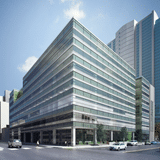Three key factors determined the relocation of the University of the Pacific’s Arthur A. Dugoni School of Dentistry: enhanced geography, more flexible learning environments, and better designed dental clinics. The promise of these things lured the school from its current home in the Pacific Heights neighborhood of San Francisco to the city’s South of Market district, where it plans to open in 2014. For the school’s 10,000 lower-income dental patients, the new location means easier access by way of the Bay Area Rapid Transit (BART), the San Francisco Municipal Railway, and city bus lines. Geometric happenstance—a square building—enabled an affordable renovation of this 40-year-old building to meet the city’s strict seismic and green building codes.
All California structures built or renovated since July 1, 2012, have to adhere to CALGreen codes. But in San Francisco, commercial-scale structures (25,000 gross square feet or larger) have to meet LEED Gold standards and withstand the inevitable earthquakes. This complicates both the building and renovation processes, but in the case of Dugoni, all contractors—general, electrical, mechanical, plumbing, and fire protection—collaborated with the architects to produce surprisingly innovative outcomes.
The building selection was a big part of meeting those codes while also staying under budget. To the surprise of the project architect—the newly renamed SmithGroupJJR of San Francisco—the selected building’s square footprint offered a distinct cost advantage. The original structural engineers built it to be nine stories tall, two more than what was actually constructed, so the existing building met current seismic codes, which helped them avert expensive structural remediation with steel bracing. “We worked this through a rigorous peer-review process,” explains Marianne O’Brien, a principal with SmithGroupJJR.
In order to bring in more sunlight and update the building, SmithGroupJJR added a glass façade. The existing building, purchased in 2011 for $47 million, had a decidedly 1970s aesthetic with small windows set in precast concrete facing its street corner. “It was important to make people comfortable and welcome there,” O’Brien says. The firm will replace the façade with a glass curtain that opens the school and clinics to a street view. Fritted glass will allow appropriate degrees of privacy and lend subtle color, while the high-performance material carries a solar-heat-gain coefficient of .29 in the winter and .26 in the summer.
Though the site does not allow for much green space, planters and a greenscreen are designed to be water-efficient, plus the school will use low-flow faucets throughout. The building’s existing mechanical systems are being fine-tuned, with new air handlers and filters and revamped refrigerants. Recharging stations are provided in the parking facilities for electrical vehicles, along with car-sharing services. Throughout, special attention was given to improving indoor air quality.
An effective building renovation saves money and overall reduces use of resources, and at the soon-to-be-built Dugoni School of Dentistry, the numbers are clear. The projected cost of renovation is $120 million, which may sound substantial, but new construction would have easily reached $135 million. “This renovation is roughly a $15 to $25 million savings versus new construction in a comparable location,” O’Brien says. That’s something to smile about.

